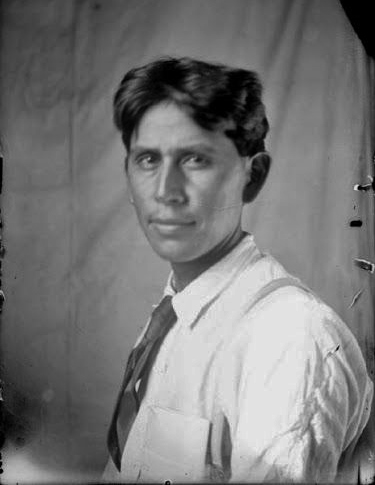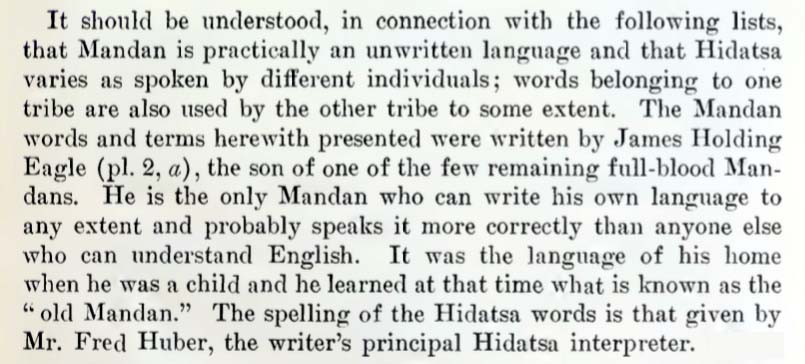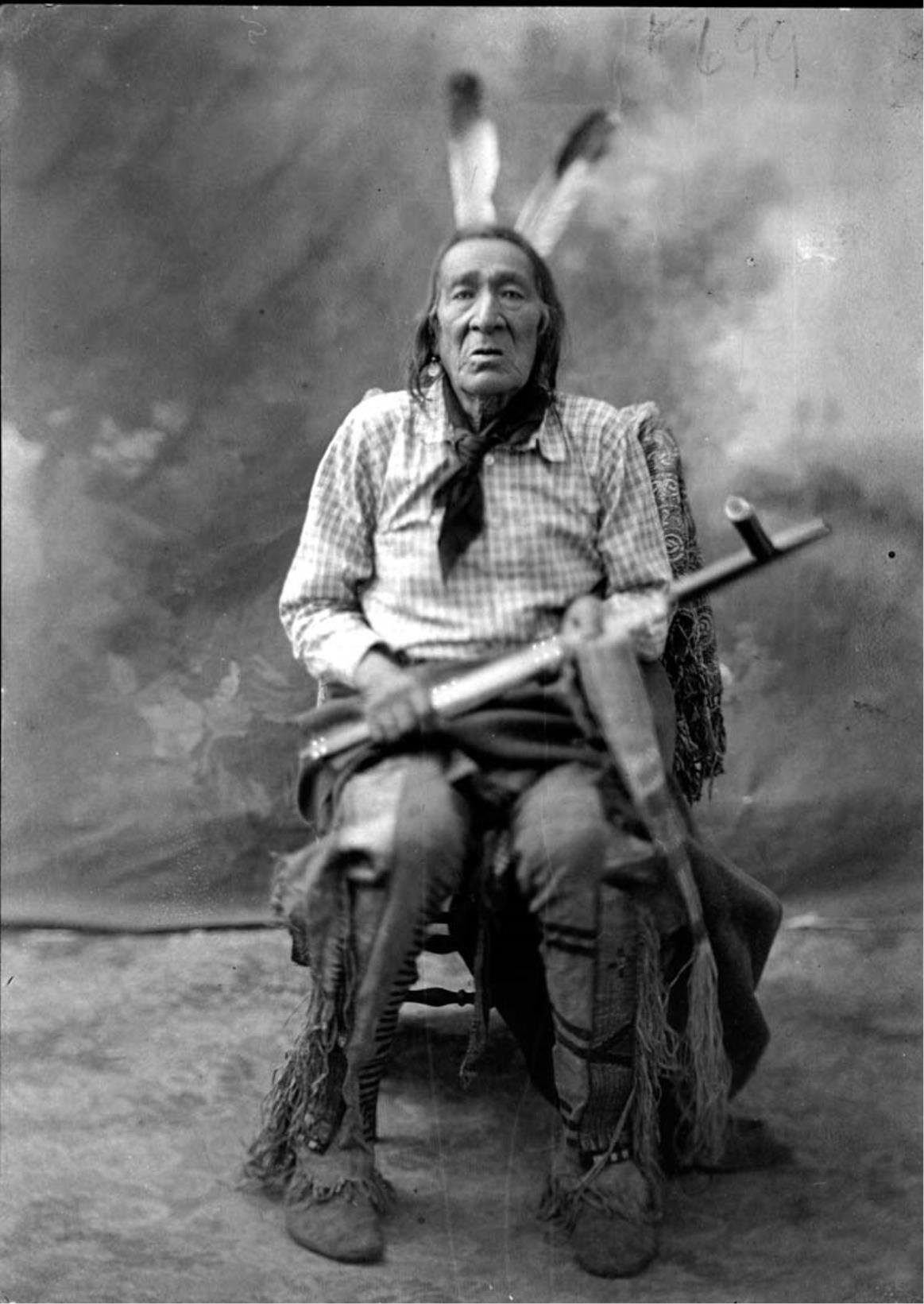Post by Dietmar on Apr 19, 2021 10:07:51 GMT -5
I`m glad to share this wonderful piece by Koos van Oostrom:
Browsing the photo collections of the State Historical Society of North Dakota, I came upon this remarkable photograph, titled ”Crows Heart, Holding Eagle, and Wolf Head in front of a Mandan Earth lodge”. The name of the photographer is not known, and the date, ca 1890, appears to be guesswork and can’t be right. I think that this date might be off by some twenty years!
![http://www.american-tribes.com/messageboards/dietmar/kooshidatsa1.jpg]()
It was the buffalo mask worn by Wolf Head that drew my attention.
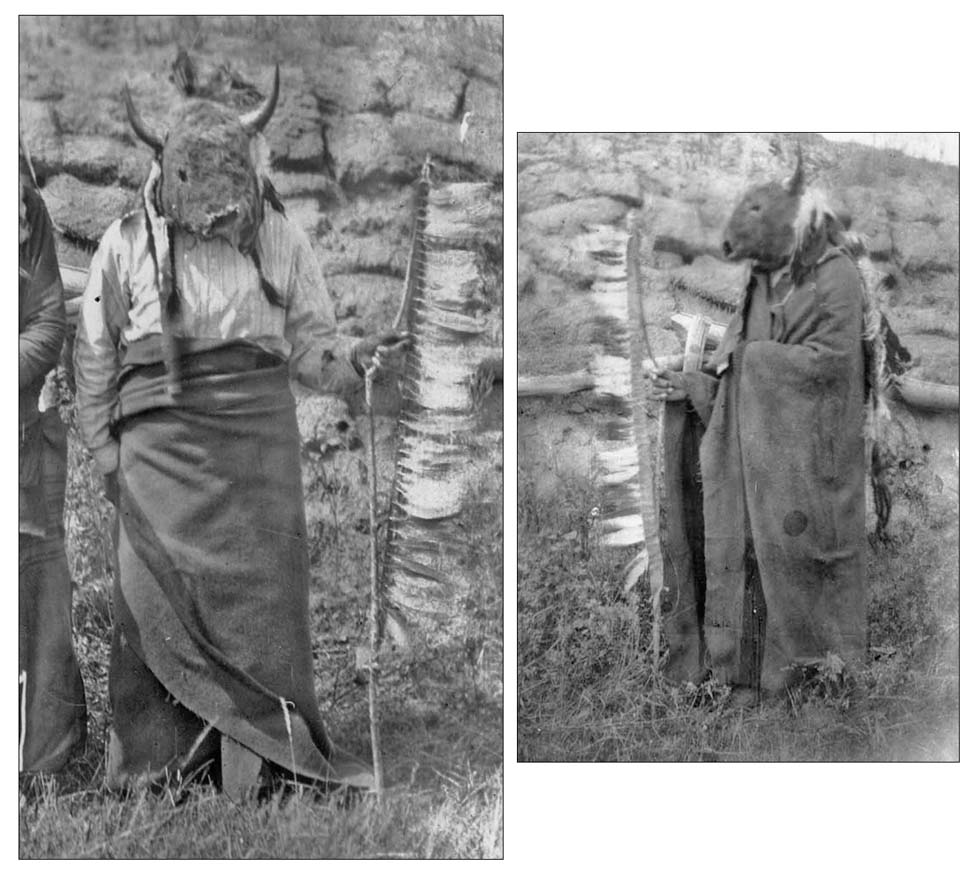
The mask appears to be a rather shabby affair - a far cry from the imposing Buffalo Bull Society masks we grew familiar with.
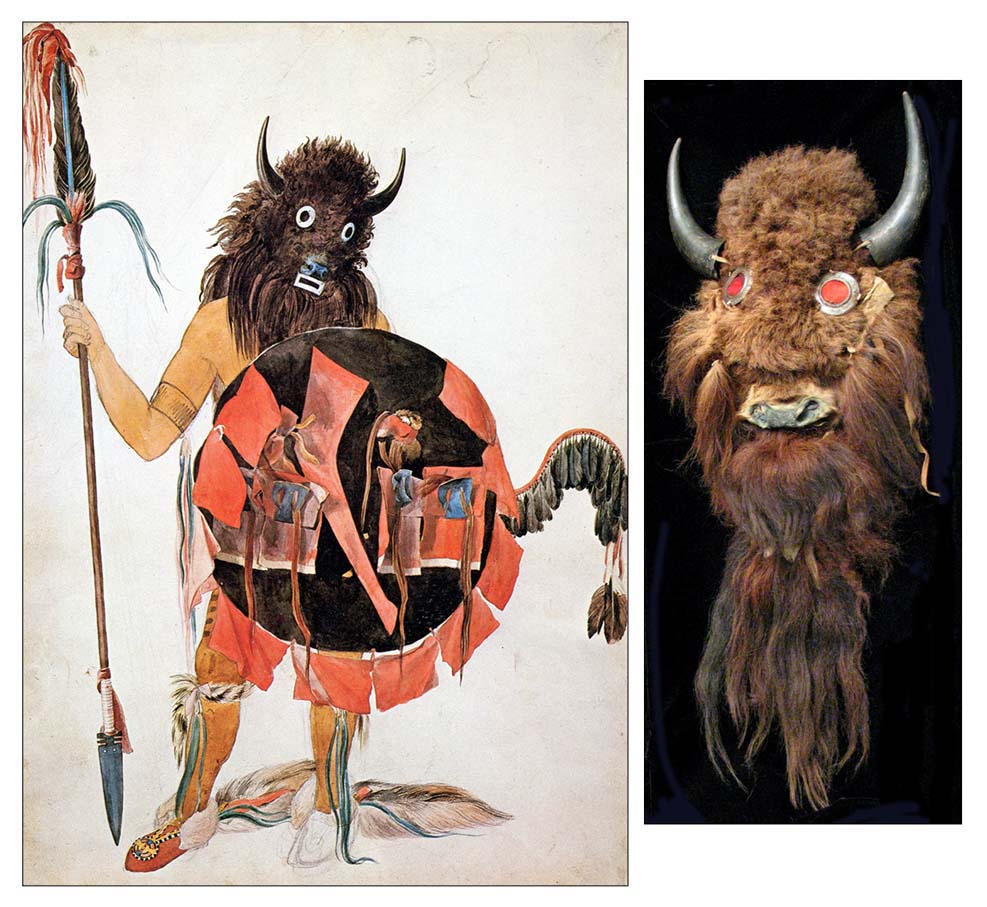
By 1883, the buffalo were gone, so renewal of masks was not an option.
Anyway, buffalo masks are a rare thing in photography, and we can’t be picky...
Crow’s Heart and Wolf Head were Mandan, and Holding Eagle Hidatsa. All three were informant for Frances Densmore. She begun her fieldwork in 1912, and it’s possible that the photos were taken around that time - although, comparing them with Curtis’ 1908 portraits of Crow’s Heart and Holding Eagle, I would date the photos between 1905 and 1910. Wilson seems another possibility.
In an effort to unravel the circumstances surrounding the photographs, I dug into these men’s history.
Very little can be found about Wolf Head. Densmore writes that he “is one of the old Mandans” - he died January 1, 1922.
Much more is known about Crow’s Heart - here’s a short biography copied from “Biographical Dictionary of the Mandan, Hidatsa, and Arikara” by Michael W. Stevens:
“Crow's Heart was born in 1856 and a member of the Prairie Chicken Clan. He was a good warrior and was the leader of the old wolves during a war party at the age of nineteen. But he gained most acclaim as a ceremonial leader owner of a number of rights and bundles. He participated in the Okipa by hanging over a cliff. At the age of 23, he first went out to trap eagles. Crow's Heart was a member of the Goose Society Singers. At about the age 30 Crow's Heart bought the right to make fish traps from his clan uncle Old Black Bear who taught him how to make the trap and how to use it. Crow's Heart was the leader of his own camp. He was one of eleven Informants for the anthropologist, Alfred Bowers in his definitive research on the Mandan and Hidatsa in the 1930's. His home was at a popular river crossing and many stopped to visit eat. It was perhaps the last place where the ancient buffalo ceremonies where performed near the mouth of the Little Missouri to break the drought that was devastating the area. He also led a group to preserve The Ark of the First Man, which commemorates the near destruction of human-kind in flood and had been a part of Mandan villages since time immemorial. Crow's Heart passed on in 1953.”
Sources: Alfred W. Bowers - Mandan Social and Ceremonial Organization. Uni. of Chicago Press.
Frances Densmore fills in some of the finer details (“Mandan and Hidatsa Music”, 1923):
“Crow’s Heart is prominent in the life of the reservation and represents an entirely different type from the other singers. that he might be termed “a man of affairs” is shown by the following incidents. The Mandan and Hidatsa village at Fort Berthold was abandoned in 1887 and the Indians subsequently were given allotments, the Mandans being located on the western side of the Missouri River and most of the Hidatsa on the eastern side, where the agency is located. Crow’s Heart’s land was on the shore of the Missouri River, making it accessible both by water and land. There he built an earth lodge of the old type, having no windows and with a corn-drying scaffold over the door. He build a comfortable log house for himself and later a two-story house for his son, who is a successful cattle raiser. Near this group of buildings he erected a “cedar post” with a paling around it, similar to that in the Mandan section of the Fort Berthold village. There is an excellent camping ground at this point, and “Crow’s Heart’s place” became a kind of communal center for the Mandans. Many feasts and gatherings were held in his earth lodge, one of which was attended by the writer, who was afterwards taken across the river by Crow’s Heart in his “bull boat,” or round hide boat of the old type. Many travelers, as well as the Indians, have been taken across in this manner, so that the location is known as “Crow’s Heart’s Landing,” or “Crow’s Heart’s Ferry,” and from this business he has acquired a considerable income.”
Crow’s Heart - compared with 1886 and 1934 portraits:
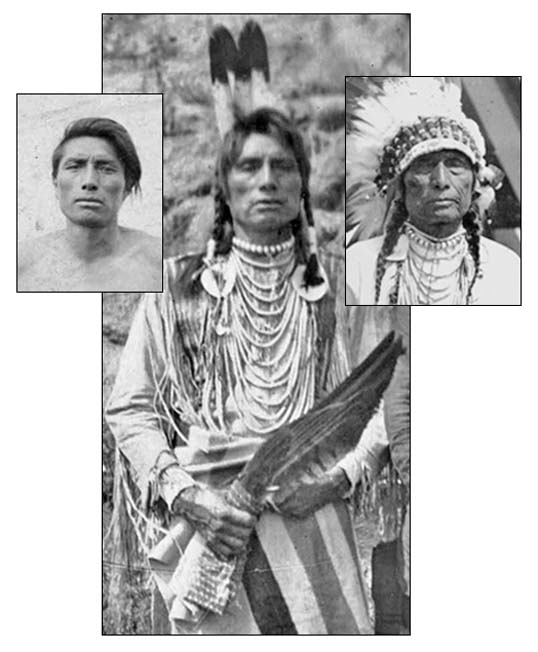
Crow’s Heart by Curtis, 1908:
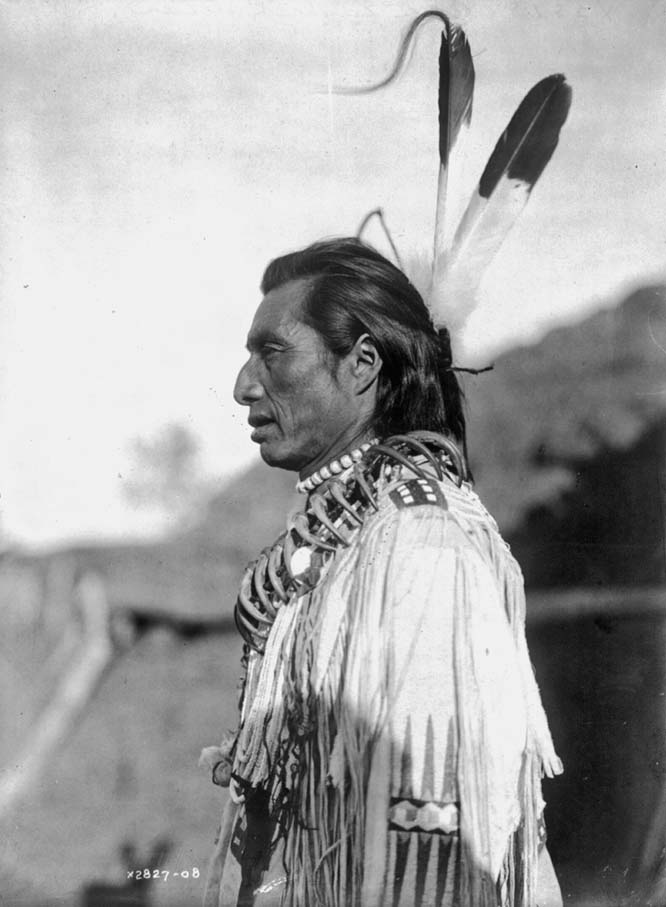
An aged Crow’s Heart:
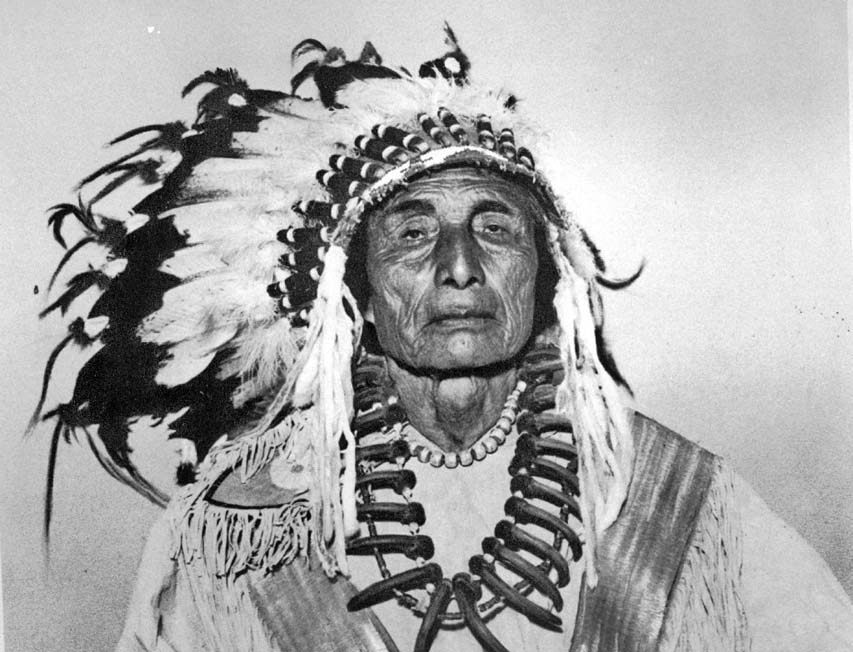
An overview of Crow’s Heart’s settlement:

Crow’s Heart on top of his earth lodge:
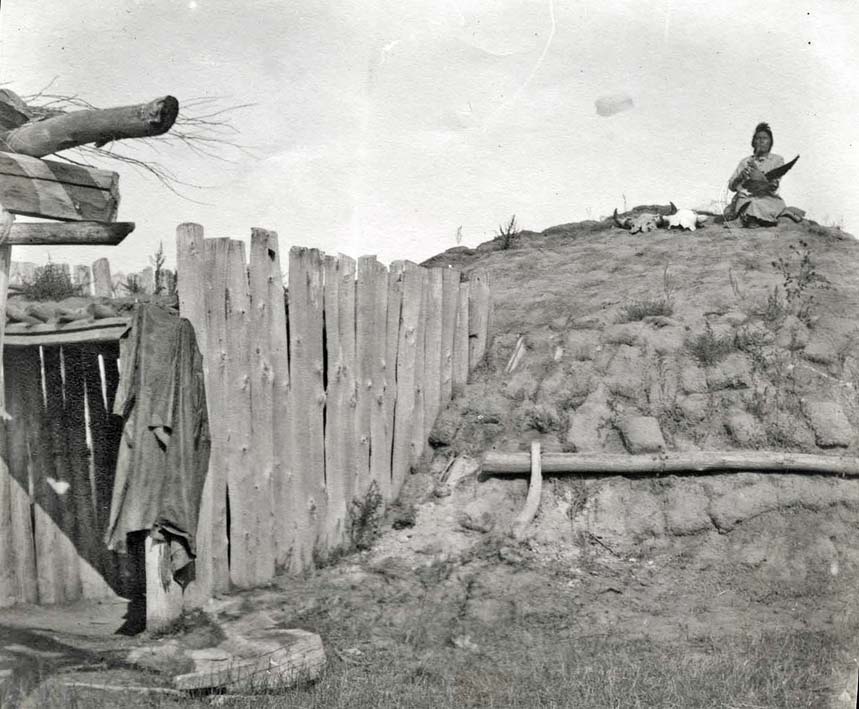
Interior of the lodge - Crow’s Heart is lacing eagle feathers to a bonnet:
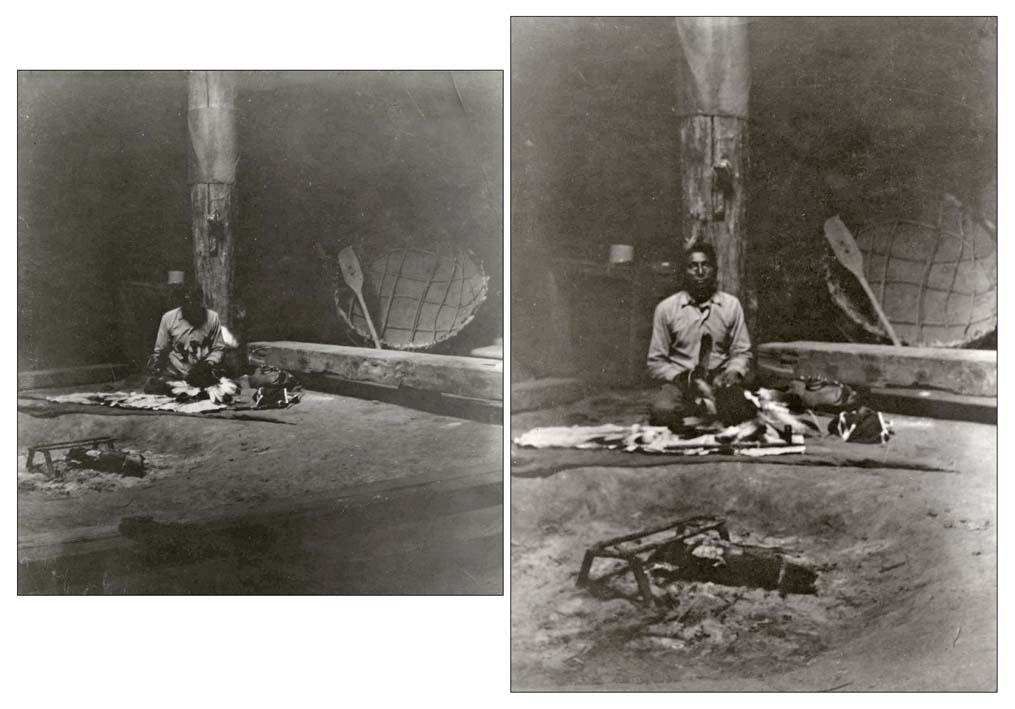
Drawing by Colonel A. B. Welch of the sacred Mandan shrine near Crow’s Heart’s place, 1923:
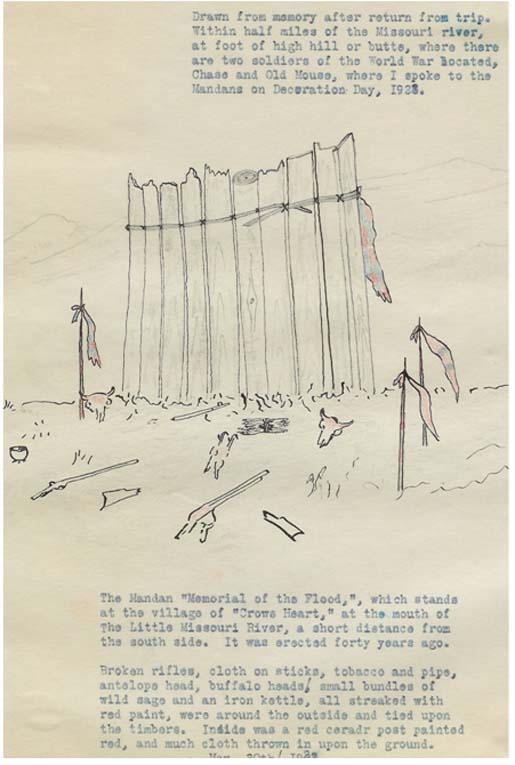
Welch’s detailed description:
www.welchdakotapapers.com/2011/12/sacred-stones-and-holy-places/#chapter-vi
The shrine on Crow’s Heart’s land - photographed by Eric E. Jacobsen in 1932:
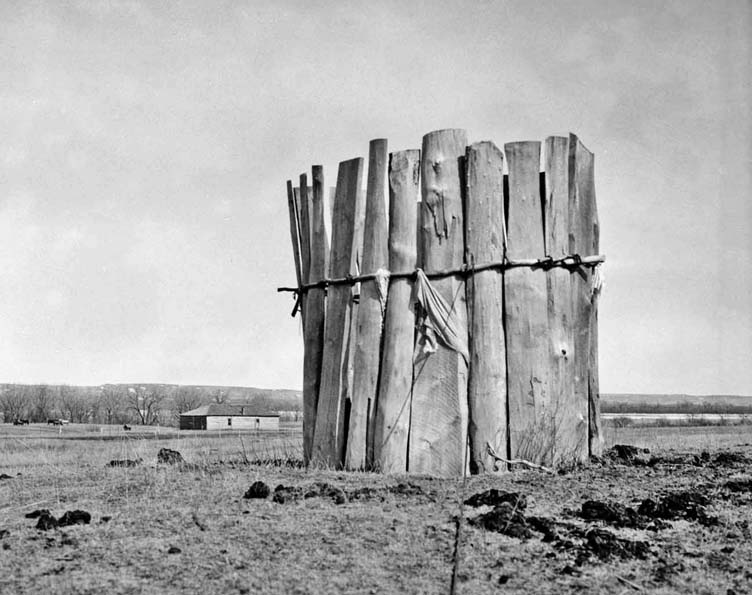
Crow’s Heart settlement “was perhaps the last place where the ancient buffalo ceremonies where performed near the mouth of the Little Missouri to break the drought that was devastating the area.”
Like-A-Fish-Hook was abandoned, lands were allotted under the Dawes Act, and the practice of tribal ceremonies was prohibited - all in the same year, 1886. The last Okipa was held in 1890 near Crow’s Heart’s place (which coincided with the great drought of 1890).
The Hidatsa Holding Eagle was also an informant for Frances Densmore - she wrote that he was “a prominent member of the tribe” - “Holding Eagle said that he was a member of the Fox Society when he was a young man, and went with them against the Sioux”.
The information he gave to Densmore, and the songs he recorded, suggest that he became a member of the Buffalo Bull Society later in life.
He also was the custodian of the sacred Mandan shrine on Crow’s Heart’s land.
Holding Eagle with headdress and gun, emblematic of the Bull Society:
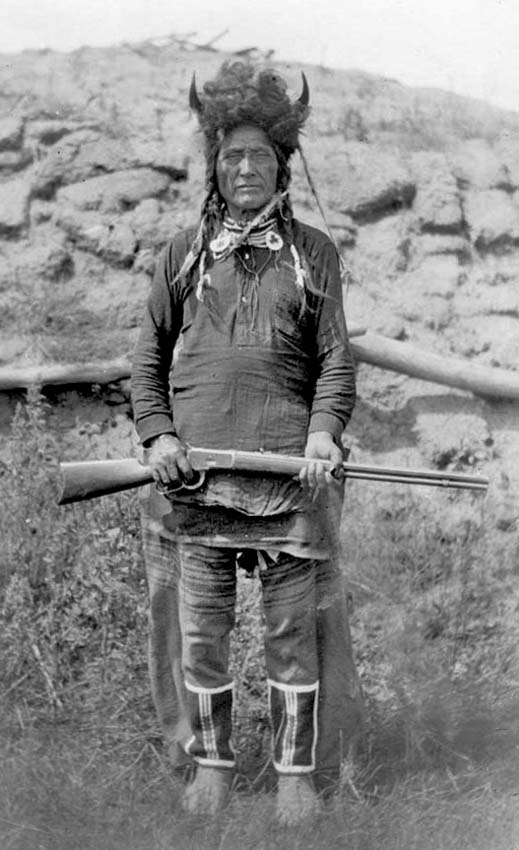
A similar headdress collected by Catlin, now in the NMNH:
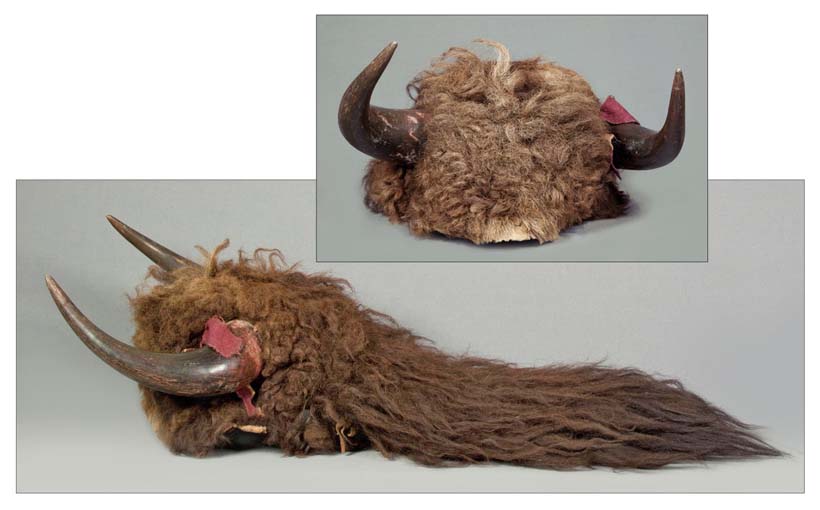
Holding Eagle, photographed by Curtis in 1908:
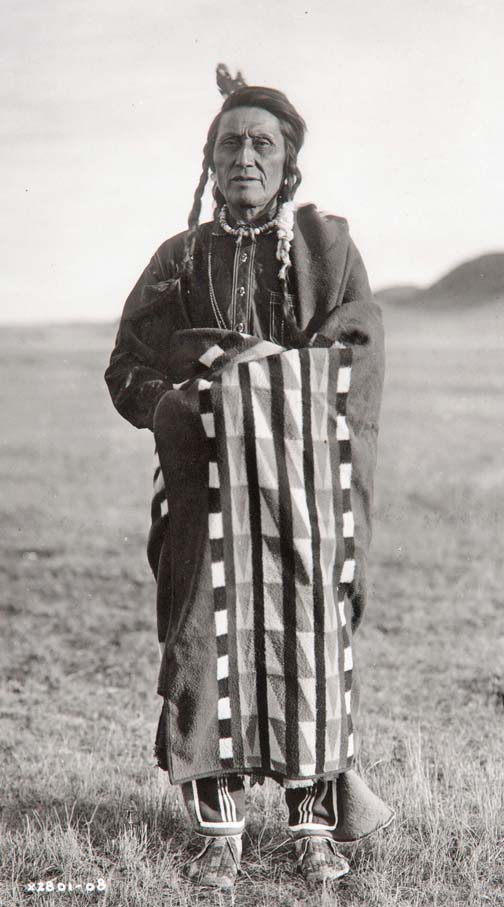
Holding Eagle with his Mandan wife Scattered Corn - she was also a Densmore informant (“What may be regarded as the oldest and most valuable material was given by Scattered Corn, daughter of Moves Slowly, the last corn priest of the Mandan, who died in1904” - Frances Densmore):
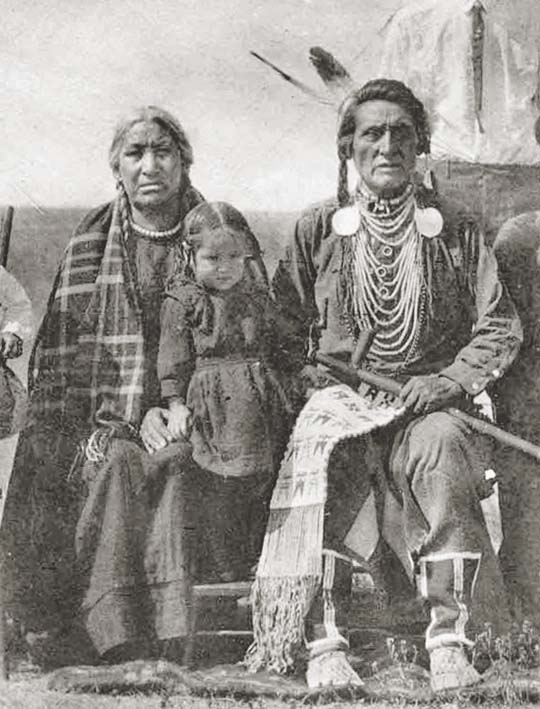
1913 Portrait by Dixon:
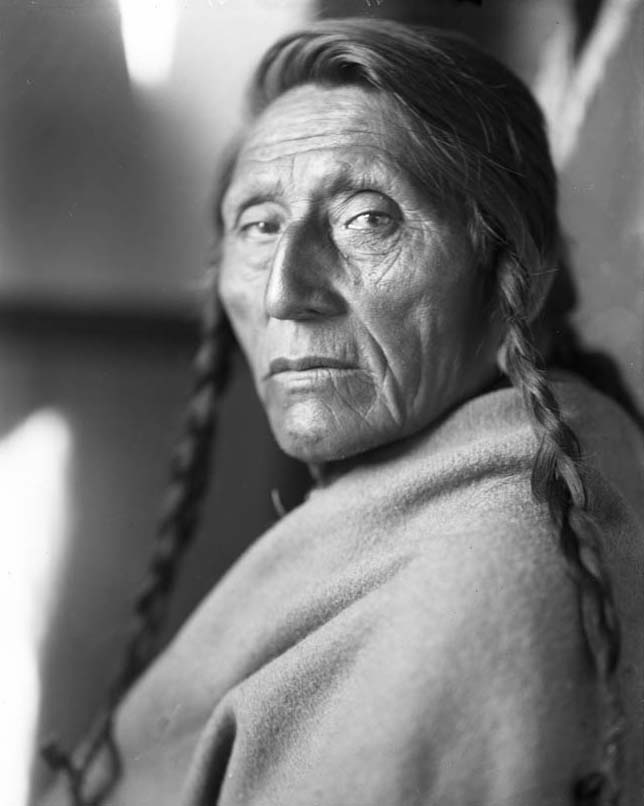
Holding Eagle died in 1918. His date of birth is not given, but according to Densmore, he died at the age of about 65 years - which would make his birthdate somewhere around 1853.
_____________________________________________________________________
Returning now to the photo of Crow’s Heart, Holding Eagle and Wolf Head in front of Crow’s Heart’s lodge:
“Crow's Heart was a Mandan spiritual leader. At this lodge located at the mouth of the Little Missouri River on the Fort Berthold Reservation he practiced the Buffalo or Bull medicine.” - George F. Will.
Holding Eagle and Wolf Head (“one of the oldest Mandans”) might have been members of the Bull Society, comprised of the “older warriors of the tribe including men of 50 and 60 years of age.”
Obviously, these were serious men, and it doesn’t seem probable that they were just dressing up to please the photographer. Possibly, they had been participating in some clandestine ceremony on Crow’s Heart’s land (of course, I’m speculating here).
Koos van Oostrom
Browsing the photo collections of the State Historical Society of North Dakota, I came upon this remarkable photograph, titled ”Crows Heart, Holding Eagle, and Wolf Head in front of a Mandan Earth lodge”. The name of the photographer is not known, and the date, ca 1890, appears to be guesswork and can’t be right. I think that this date might be off by some twenty years!
It was the buffalo mask worn by Wolf Head that drew my attention.

The mask appears to be a rather shabby affair - a far cry from the imposing Buffalo Bull Society masks we grew familiar with.

By 1883, the buffalo were gone, so renewal of masks was not an option.
Anyway, buffalo masks are a rare thing in photography, and we can’t be picky...
Crow’s Heart and Wolf Head were Mandan, and Holding Eagle Hidatsa. All three were informant for Frances Densmore. She begun her fieldwork in 1912, and it’s possible that the photos were taken around that time - although, comparing them with Curtis’ 1908 portraits of Crow’s Heart and Holding Eagle, I would date the photos between 1905 and 1910. Wilson seems another possibility.
In an effort to unravel the circumstances surrounding the photographs, I dug into these men’s history.
Very little can be found about Wolf Head. Densmore writes that he “is one of the old Mandans” - he died January 1, 1922.
Much more is known about Crow’s Heart - here’s a short biography copied from “Biographical Dictionary of the Mandan, Hidatsa, and Arikara” by Michael W. Stevens:
“Crow's Heart was born in 1856 and a member of the Prairie Chicken Clan. He was a good warrior and was the leader of the old wolves during a war party at the age of nineteen. But he gained most acclaim as a ceremonial leader owner of a number of rights and bundles. He participated in the Okipa by hanging over a cliff. At the age of 23, he first went out to trap eagles. Crow's Heart was a member of the Goose Society Singers. At about the age 30 Crow's Heart bought the right to make fish traps from his clan uncle Old Black Bear who taught him how to make the trap and how to use it. Crow's Heart was the leader of his own camp. He was one of eleven Informants for the anthropologist, Alfred Bowers in his definitive research on the Mandan and Hidatsa in the 1930's. His home was at a popular river crossing and many stopped to visit eat. It was perhaps the last place where the ancient buffalo ceremonies where performed near the mouth of the Little Missouri to break the drought that was devastating the area. He also led a group to preserve The Ark of the First Man, which commemorates the near destruction of human-kind in flood and had been a part of Mandan villages since time immemorial. Crow's Heart passed on in 1953.”
Sources: Alfred W. Bowers - Mandan Social and Ceremonial Organization. Uni. of Chicago Press.
Frances Densmore fills in some of the finer details (“Mandan and Hidatsa Music”, 1923):
“Crow’s Heart is prominent in the life of the reservation and represents an entirely different type from the other singers. that he might be termed “a man of affairs” is shown by the following incidents. The Mandan and Hidatsa village at Fort Berthold was abandoned in 1887 and the Indians subsequently were given allotments, the Mandans being located on the western side of the Missouri River and most of the Hidatsa on the eastern side, where the agency is located. Crow’s Heart’s land was on the shore of the Missouri River, making it accessible both by water and land. There he built an earth lodge of the old type, having no windows and with a corn-drying scaffold over the door. He build a comfortable log house for himself and later a two-story house for his son, who is a successful cattle raiser. Near this group of buildings he erected a “cedar post” with a paling around it, similar to that in the Mandan section of the Fort Berthold village. There is an excellent camping ground at this point, and “Crow’s Heart’s place” became a kind of communal center for the Mandans. Many feasts and gatherings were held in his earth lodge, one of which was attended by the writer, who was afterwards taken across the river by Crow’s Heart in his “bull boat,” or round hide boat of the old type. Many travelers, as well as the Indians, have been taken across in this manner, so that the location is known as “Crow’s Heart’s Landing,” or “Crow’s Heart’s Ferry,” and from this business he has acquired a considerable income.”
Crow’s Heart - compared with 1886 and 1934 portraits:

Crow’s Heart by Curtis, 1908:

An aged Crow’s Heart:

An overview of Crow’s Heart’s settlement:

Crow’s Heart on top of his earth lodge:

Interior of the lodge - Crow’s Heart is lacing eagle feathers to a bonnet:

Drawing by Colonel A. B. Welch of the sacred Mandan shrine near Crow’s Heart’s place, 1923:

Welch’s detailed description:
www.welchdakotapapers.com/2011/12/sacred-stones-and-holy-places/#chapter-vi
The shrine on Crow’s Heart’s land - photographed by Eric E. Jacobsen in 1932:

Crow’s Heart settlement “was perhaps the last place where the ancient buffalo ceremonies where performed near the mouth of the Little Missouri to break the drought that was devastating the area.”
Like-A-Fish-Hook was abandoned, lands were allotted under the Dawes Act, and the practice of tribal ceremonies was prohibited - all in the same year, 1886. The last Okipa was held in 1890 near Crow’s Heart’s place (which coincided with the great drought of 1890).
The Hidatsa Holding Eagle was also an informant for Frances Densmore - she wrote that he was “a prominent member of the tribe” - “Holding Eagle said that he was a member of the Fox Society when he was a young man, and went with them against the Sioux”.
The information he gave to Densmore, and the songs he recorded, suggest that he became a member of the Buffalo Bull Society later in life.
He also was the custodian of the sacred Mandan shrine on Crow’s Heart’s land.
Holding Eagle with headdress and gun, emblematic of the Bull Society:

A similar headdress collected by Catlin, now in the NMNH:

Holding Eagle, photographed by Curtis in 1908:

Holding Eagle with his Mandan wife Scattered Corn - she was also a Densmore informant (“What may be regarded as the oldest and most valuable material was given by Scattered Corn, daughter of Moves Slowly, the last corn priest of the Mandan, who died in1904” - Frances Densmore):

1913 Portrait by Dixon:

Holding Eagle died in 1918. His date of birth is not given, but according to Densmore, he died at the age of about 65 years - which would make his birthdate somewhere around 1853.
_____________________________________________________________________
Returning now to the photo of Crow’s Heart, Holding Eagle and Wolf Head in front of Crow’s Heart’s lodge:
“Crow's Heart was a Mandan spiritual leader. At this lodge located at the mouth of the Little Missouri River on the Fort Berthold Reservation he practiced the Buffalo or Bull medicine.” - George F. Will.
Holding Eagle and Wolf Head (“one of the oldest Mandans”) might have been members of the Bull Society, comprised of the “older warriors of the tribe including men of 50 and 60 years of age.”
Obviously, these were serious men, and it doesn’t seem probable that they were just dressing up to please the photographer. Possibly, they had been participating in some clandestine ceremony on Crow’s Heart’s land (of course, I’m speculating here).
Koos van Oostrom

